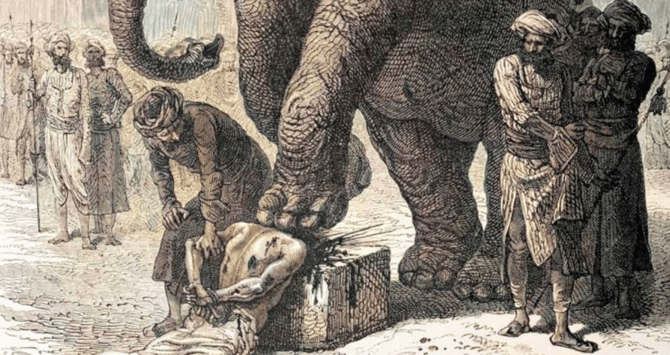Execution by elephant, also known as “death by elephant,” was a gruesome form of capital punishment that prevailed across various ancient civilizations. Employing elephants as instruments of execution was a method that instilled fear and awe in the minds of spectators. This article will explore the historical significance of execution by elephant, its geographical spread, and some notable instances of its application.
Geographical Spread
The practice of execution by elephant was primarily prevalent in the Indian subcontinent and Southeast Asia. Countries such as India, Sri Lanka, Myanmar, Thailand, and parts of the Malay Peninsula were known to employ elephants in capital punishment. These regions were home to flourishing ancient empires and kingdoms that utilized elephants for various purposes, including warfare and construction.
India
In ancient India, elephants held immense cultural and military significance. The Mauryan Empire (322 BCE – 185 BCE), under the rule of Emperor Ashoka, witnessed the practice of execution by elephant. According to historical accounts, Emperor Ashoka employed elephants to execute criminals, enemies, and rebels as a means of displaying imperial power and deterring dissent. Regions such as Magadha, Pataliputra (modern-day Patna), and Ujjain witnessed such executions.
Sri Lanka
Execution by elephant also found its place in ancient Sri Lanka, which was known as Ceylon in earlier times. The Sinhalese kingdoms utilized elephants for both war and public punishment. The Chronicles of Sri Lanka, known as the Mahavamsa, detail several instances of execution by elephant. Notably, King Dutugemunu (161 BCE – 137 BCE) reportedly employed elephants for executing prisoners of war and political rivals.
Southeast Asia
Execution by elephant was widespread in various Southeast Asian kingdoms. Myanmar (formerly Burma) witnessed this practice during the reign of monarchs such as King Anawrahta (1044 CE – 1077 CE) of the Pagan Empire. Thailand, known as Siam in the past, also employed elephants for capital punishment. The Ayutthaya Kingdom, between the 14th and 18th centuries, executed criminals and prisoners of war through this brutal method.
Execution Process
The process of execution by elephant typically involved the captive elephant trampling or crushing the condemned person under its immense weight. The condemned individual would often be restrained and presented before a trained execution elephant. The animal, under the guidance of a mahout (elephant handler), would carry out the execution by stomping or trampling upon the prisoner.
Over time, as civilizations evolved, the practice of execution by elephant gradually declined. The emergence of more humane forms of punishment and changing societal norms led to its eventual abolition. By the 19th and 20th centuries, execution by elephant had become a rare occurrence, eventually fading into history.
Execution by elephant stands as a chilling testament to the harsh realities of ancient civilizations. The geographical spread of this practice across India, Sri Lanka, Myanmar, Thailand, and the Malay Peninsula highlights its significance in the cultures and histories of these regions. Though we now view this form of punishment with abhorrence, understanding its historical context provides valuable insights into the evolution of justice and societal norms throughout human history.





